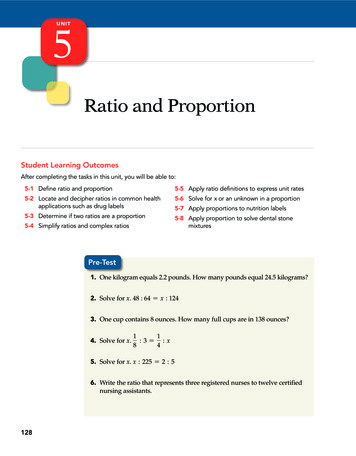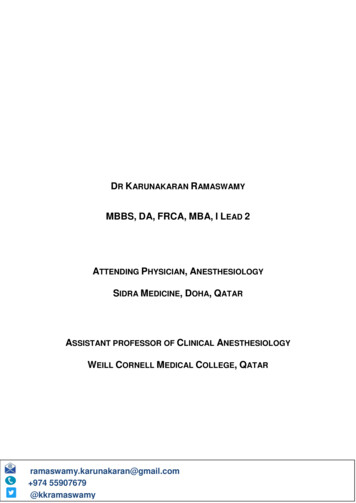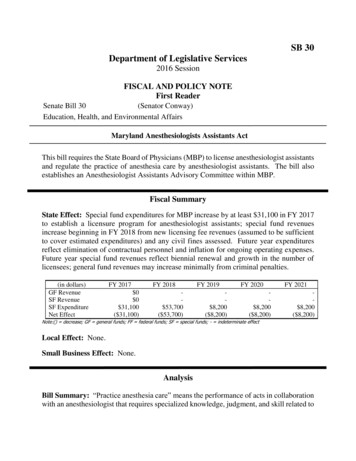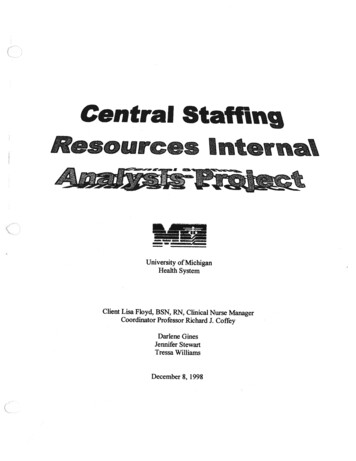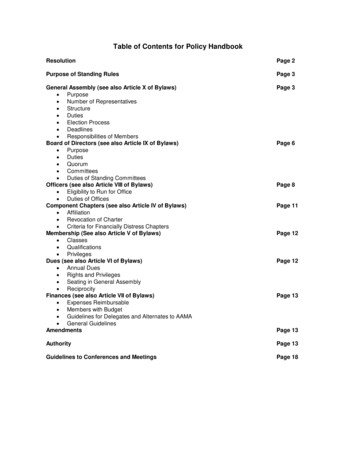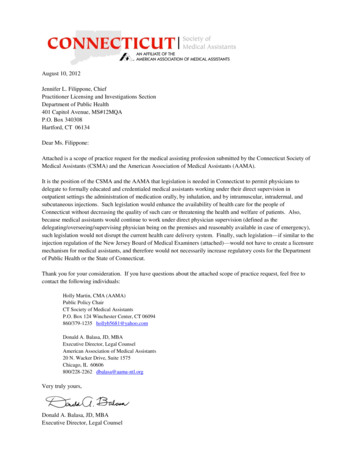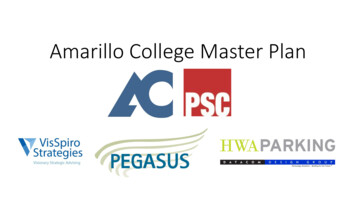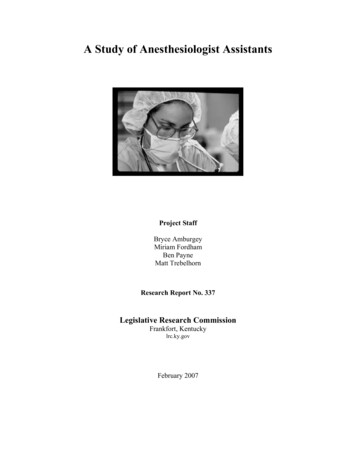
Transcription
A Study of Anesthesiologist AssistantsProject StaffBryce AmburgeyMiriam FordhamBen PayneMatt TrebelhornResearch Report No. 337Legislative Research CommissionFrankfort, Kentuckylrc.ky.govFebruary 2007
A Study of Anesthesiologist AssistantsProject StaffBryce AmburgeyMiriam FordhamBen PayneMatt TrebelhornResearch Report No. 337Legislative Research CommissionFrankfort, Kentuckylrc.ky.govFebruary 2007Paid for with state funds. Available in alternative form by request.
Legislative Research CommissionForewordForewordThe 2006 General Assembly directed the Legislative Research Commission to study thecertification and scope of practice requirements of anesthesiologist assistants and tocompare similarities and differences between Kentucky and other states whereanesthesiologist assistants practice. The General Assembly also mandated a comparisonof anesthesiologist assistant practice to that of other anesthesia care providers. In thecourse of the study, anesthesiologist assistant regulation in other states was reviewed andevaluated, along with the regulation of other anesthesia care providers in thosejurisdictions. In addition, testimony from interested parties was gathered. This reportrepresents the results of that study.Legislative Research Commission staff would like to acknowledge the information andtestimony provided from several organizations and associations. These included theAmerican Academy of Anesthesiologist Assistants, Kentucky Association of NurseAnesthetists, Kentucky Society of Anesthesiologists, Kentucky Nurses Association,Kentucky Board of Medical Licensure, Kentucky Medical Association, KentuckyHospital Association, Kentucky Board of Nursing, Kentucky Association of PhysicianAssistants, Kentucky Association of Health Plans, and Kentucky Cabinet for Health andFamily Services. Additionally, several individuals, including four anesthesiologistassistants, provided information and testimony and are specifically acknowledged in thereport.As directed by the General Assembly, this study was presented to the LegislativeResearch Commission on December 15, 2006, for eventual referral to the appropriateinterim joint committees.Robert ShermanDirectorLegislative Research CommissionFrankfort, KentuckyFebruary 6, 2006Cover photo courtesy of the National Institutes of Health/Department of Health and Human Services,Image Bank.i
ii
Legislative Research CommissionContentsContentsSummary . viiChapter 1: The Anesthesiologist Assistant Profession .1Introduction.1History and Description of Anesthesiologist Assistants.1Current Issues Relating to Anesthesiologist Assistants .2Florida Anesthesiologist Assistants .2Training and Education.3CAAHEP Accreditation of Programs .3Curriculum and Clinical Hours.5Certification and Licensure Requirements.6NCCAA Certificate and Examination .7Continuing Education .7Continued Demonstration of Qualifications Examination.8Scope of Practice.9Supervision .9Prescriptive Authority.9Anesthesia Care Team Model.10Patient Safety .11Patient Access to Care .12Chapter 2: Anesthesiologist Assistants in Kentucky Compared to Other Jurisdictions .13Training and Education.13Certification and Licensure Requirements.14Scope of Practice.16Emerging Trends.18Recent Actions Against Anesthesiologist Assistant Practice .18Recent Actions Favoring Anesthesiologist Assistant Practice .18Types of States Where Anesthesiologist Assistants Practice .19Federal Position Toward Anesthesiologist Assistants .20Chapter 3: Anesthesiologist Assistants Compared to Other Anesthesia Providers .21Types of Providers .21Kentucky Differences and Similarities BetweenAnesthesiologist Assistants and Nurse Anesthetists.23Training and Education.23Certification and Licensure Requirements.24Scope of Practice.24Kentucky Geographic Distribution of Anesthesia Care Providers .25Kentucky Compared to Other Anesthesiologist Assistant Jurisdictions inTreatment of Comparable Anesthesia Care Professions.25Training and Education.25Certification and Licensure Requirements.27Scope of Practice.32iii
ContentsLegislative Research CommissionChapter 4: Opinions of Interested and Affected Parties .33Overview.33Parties Interviewed.33Anesthesiologist Assistants Compared to Other Anesthesia Care Providers .34Anesthesiologist Assistant Practice Issues.35Anesthesia Care Provider Jobs and Salaries .37Anesthesiologist Assistant Impact on Kentucky Health Care .38Impact on Urban vs. Rural Areas.39Safety and Quality of Care.40Other Issues for Related Practitioners.40Other Parties Contacted .41Works Cited .43Appendix A: Florida Anesthesiologist Assistant Scope of Practice Statutes .45Appendix B: Anesthesiologist Assistant Supervision Levels and Ratios .47Appendix C: Proximity of Anesthesiologist Assistant Education Programs toAnesthesiologist Assistant Practice Jurisdictions .49Appendix D: Kentucky Anesthesiologist Assistant Statutes .51Appendix E: Number and Type of Anesthesia Providers by County .55Appendix F: Number and Type of Anesthesia Providers by County .59List of Tables1.1Anesthesiologist Assistant Education Programs.42.1Type of Anesthesiologist Assistant Practice by State.152.2Anesthesiologist Assistant Prescriptive Authority.172.3State Population Ranking of Anesthesiologist Assistant Jurisdictions.203.1Nurse Anesthetist Educational Requirements.263.2Length of Time New Certified Registered Nurse Anesthetist GraduatesMay Temporarily Practice Without National Certification .283.3Nurse Anesthetist National Certification andRecertification Requirements and Practice Recognition .31iv
Legislative Research CommissionContents4.1Party Opinions on Anesthesiologist Assistant Practice Issues .364.2Anesthesiologist Assistant Impact on Kentucky Health Care .39v
Legislative Research CommissionSummarySummarySenate Bill 175 of the 2006 General Assembly directed a study of anesthesiologistassistants. The study mandate included research of anesthesiologist assistants comparedto other anesthesia care providers and discussion of the regulatory environment regardinganesthesia care providers in Kentucky compared to other jurisdictions whereanesthesiologist assistants practice.Anesthesiologist assistants are authorized to practice in Kentucky, along with 14 otherstates and the District of Columbia. They are allied health professionals who work underthe direction of licensed anesthesiologists to develop and implement anesthesia careplans. Anesthesiologist assistants perform a variety of tasks and work exclusively withinthe anesthesia care team environment. For example, they may administer drugs, establishand maintain patient airway, and assess and monitor patients.While there are approximately 700 anesthesiologist assistants practicing nationwide,there are only two currently practicing in Kentucky, and both of these practitioners wereexempted when the current law requiring anesthesiologist assistants to also be physicianassistants was enacted. Kentucky has a unique educational requirement among thosejurisdictions that allow practice by anesthesiologist assistants. To practice in Kentucky,the anesthesiologist assistant must have graduated from both an anesthesiologist assistantprogram and a four-year physician assistant program. Interested parties disagreed on thewisdom of the physician assistant graduation requirement for anesthesiologist assistants.However, the parties that took a position on the issue agreed that this requirement hasplayed a role in the fact that no new anesthesiologist assistants have been licensed inKentucky under the current system.There are four accredited anesthesiologist assistant training programs in the UnitedStates, with the two oldest founded in 1969. All anesthesiologist assistant programsrequire either the Graduate Record Examination or Medical College Admission Testentrance exam and a bachelor's degree with prerequisite course work in science, math,and English. The number of course work hours and clinical hours required for completionof the anesthesiologist assistant degree program varies from 63 to 158 hours of coursework and from 2,000 to about 2,700 clinical hours. As part of their training,anesthesiologist assistant candidates must complete a clinical rotation in all subspecialtiesof anesthesia with additional training in regional anesthesia and invasive line placement.The anesthesiologist assistant programs are accredited by the Commission for theAccreditation of Allied Health Education Programs.Initial certification is awarded upon successful completion of the certifying examinationadministered by the National Commission for Certification of AnesthesiologistAssistants. Recertification requires documentation of completion of 40 hours ofcontinuing medical education credits every two years and successful completion of theexamination for Continued Demonstration of Qualifications every six years.vii
SummaryLegislative Research CommissionThere have been no major studies comparing patient safety or other relevant factors whenanesthesia care is provided in an anesthesiologist assistant environment as opposed toother anesthesia care environments. Research indicates that certified registered nurseanesthetists (nurse anesthetists) are the only other anesthesia care providers that merit adirect comparison with anesthesiologist assistants. At present, there are about 35,000nurse anesthetists practicing nationally, authorized in every jurisdiction in the UnitedStates.There are many similarities between nurse anesthetists and anesthesiologist assistants, butthe four main differences are curriculum prerequisites, scope of practice, practicejurisdictions, and governing entities. First, nurse anesthetist educational programs requirespecific nursing degree training for admission, while anesthesiologist assistant programsdo not specify required undergraduate majors but require some related course work.Second, anesthesiologist assistants are not allowed to practice in any jurisdiction withoutthe direct supervision of an anesthesiologist, while nurse anesthetists may practice underthe supervision of any physician or in collaboration without specific supervision in thosestates that have chosen to "opt-out" of Medicare reimbursement for such services. Third,nurse anesthetists practice in every jurisdiction nationwide under a license or itsequivalent, while anesthesiologist assistants practice in only 16 jurisdictions, underlicensure in 10 of those jurisdictions and under physician delegation in the other 6.Fourth, nurse anesthetists are always governed by the state's nursing board, whileanesthesiologist assistants are always governed by the state's medical board.Kentucky data was limited since only two anesthesiologist assistants practice in the state.Interviews were conducted with several interested parties for this study. While theinterviews were designed to meet the study's mandate of direct comparison amongjurisdictions and professions, many also led to that party's view of whether Kentuckyshould keep or change its current system governing the practice of anesthesiologistassistants. Opinions differed, with parties having strong opinions for or against changeand several parties choosing to take a neutral stance on the issue.Kentucky's treatment of all anesthesia care providers is consistent with other jurisdictionsthat allow practice by anesthesiologist assistants, with one exception. Kentucky requiresthat an anesthesiologist assistant attain degrees as both an anesthesiologist assistant andas a physician assistant.viii
Legislative Research CommissionChapter 1Chapter 1The Anesthesiologist Assistant ProfessionIntroductionHealth care providers known as anesthesiologist assistants are asmall but growing group whose profession has fairly recentorigins. These practitioners are available in several jurisdictions asan option for an anesthesia care team. The majority of states do notcurrently allow anesthesiologist assistant practice. Some consideranesthesiologist assistants to be highly skilled and highly trainedpractitioners who are qualified to administer anesthesia under thesupervision of an anesthesiologist. Others view anesthesiologistassistants as not having the required educational or otherbackground to safely administer anesthesia care.This chapter provides an overview of the anesthesiologist assistantprofession by exploring what it is, its history, and its current issues.Also, qualifications of anesthesiologist assistants are reviewed bylooking at anesthesiologist assistant training and education,certification and licensure requirements, and scope of practice.Finally, Chapter 1 investigates the impact of anesthesiologistassistants on patient safety and access to care.History and Description of Anesthesiologist AssistantsThe first anesthesiologist assistantprograms began at EmoryUniversity and Case WesternReserve University in 1969.The first anesthesiologist assistant programs were started at EmoryUniversity and Case Western Reserve University in 1969. Theimpetus of the education program and profession was the physicianshortage faced by the field of anesthesiology in the mid-1960s, theshortage of nurses in anesthesia, and the increasing technologicaldemands of the field. In response, three anesthesiologists proposedthe concept of an "anesthesia technologist" who would be amember of the anesthesia team and be considered an "appliedphysiologist" (Gravenstein 356).It was envisioned that this new anesthesia professional would havea bachelor's degree in science with premedical training and beawarded a master's degree that allowed for both vertical mobilitytoward a medical degree and lateral mobility into other areasrequiring training in biomedical equipment and physiologicmeasurement. The anesthesiologist assistant would remain under1
Chapter 1Legislative Research Commissionthe supervision of the anesthesiologist as "responsibility andimmediate care of the patient must remain within the province ofthe anesthesiologist; consequently, personnel could not workindependently but only under the immediate direction of theanesthesiologist. An advantage in manpower for theanesthesiologist would result, as he could provide attention toseveral patients with the proper employment of the anesthesiateam, as described above" (Gravenstein 357).A small number ofanesthesiologist assistantspractice compared to other similarprofessions, and the practice hasremained largely regionalized.Since its inception, the anesthesiologist assistant profession hasgrown but remains a largely regionalized profession due to thesmall number of programs, which until recently numbered onlytwo; and the limited number of jurisdictions, 16, whereanesthesiologist assistants are authorized to practice. In 1989, theNational Commission for Certification of AnesthesiologistAssistants was formed to establish a national certification process.Today, the American Society of Anesthesiologists considersanesthesiologist assistants to be mid-level anesthesia providerswho work under the direction of an anesthesiologist and participatein the provision of anesthesia, performing such tasks asadministering drugs, obtaining vascular access, applying andinterpreting monitors, establishing and maintaining patient airway,and assisting with preoperative assessment (Emory).Current Issues Relating to Anesthesiologist AssistantsFlorida Anesthesiologist AssistantsFlorida began discussing the anesthesiologist assistant professionin 2001. Anesthesia physicians wanted a new type of anesthesiaprovider to alleviate the shortage of help for anesthesia teams.Also, those physicians felt that using only nurse anesthetistsdrained the already small pool of nurses available for moregeneralized work (Lundine).In 2004, anesthesiologist assistantlicensing was implemented inFlorida.In 2004, Florida enacted Senate Bill 626, which established theanesthesiologist assistant profession in that state. The bill requiredthat anesthesiologist assistants be directly supervised by ananesthesiologist, work pursuant to a written protocol filed with themedical board, and practice in accordance with the scope ofpractice defined in the legislation and as further defined by themedical board. The debate on the issue was intense. The FloridaAssociation of Nurse Anesthetists (FANA) opposed the FloridaSociety of Anesthesiologists (FSA) to try to preventanesthesiologist assistants from practicing in Florida. FANA stated2
Legislative Research CommissionChapter 1that anesthesiologist assistants were not adequately educated andtrained, and FSA argued that they were adequately educated andtrained. After much media attention and debate, the bill passed andwas signed into law by Governor Jeb Bush (Turpin). The Governorstated that he recognized that there are "differences in trainingbetween nurse anesthetists and anesthesiologist assistants, but thedifference does not equate to inferiority" (Maine Nurse).Nova Southeastern University in Ft. Lauderdale, Florida,established a Master of Health Science Anesthesiologist AssistantProgram in 2005. This program will graduate anesthesiologistassistant students within the next few years.Training and EducationCAAHEP Accreditation of ProgramsThere are four accreditedanesthesiologist assistant schoolsin the U.S. Accreditation isgranted by the Commission onAccreditation of Allied HealthEducation Programs (CAAHEP).Anesthesiologist assistants graduate from one of four accreditededucational programs in the U.S. The programs are located atEmory University in Atlanta, Georgia; Case Western ReserveUniversity in Cleveland, Ohio; Nova Southeastern University inFort Lauderdale, Florida; and South University in Savannah,Georgia. These programs are accredited by the Commission onAccreditation of Allied Health Education Programs (CAAHEP).CAAHEP is the largest programmatic accreditor in the healthsciences field. Through its Committees on Accreditation,CAAHEP reviews and accredits more than 2,000 educationalprograms in 19 health science occupations and is recognized by theCouncil for Higher Education Accreditation (Commission. Home).The four schools of medicine associated with these programs areaccredited by the Liaison Committee on Medical Education.Additionally, the programs meet the criteria for accreditation bythe Accreditation Council for Graduate Medical Education foranesthesia residency training programs (Commission. Standards2).The education requirements are similar among the programs. TheStandards and Guidelines of CAAHEP requires that theanesthesiologist assistant program build on a pre-professionalstudy of the sciences that would allow a student to pursue anadvanced degree program in medical science (6). A bachelor'sdegree with specific prerequisite courses in science, math, andEnglish are required for entrance into an anesthesiologist assistantprogram. An entrance exam is also required for admittance(American Society. Frequently). Emory, Nova Southeastern, and3
Chapter 1Legislative Research CommissionSouth Universities accept entrance exam scores from the GraduateRecord Examination (GRE) or the Medical College AdmissionTest (MCAT). Case Western Reserve University only acceptsentrance exam scores from the MCAT.Table 1.1Anesthesiologist Assistant Education ProgramsLocationEntranceExamRequired ForProgram*Term ofProgramNumber ofClinicalHours inProgramCurriculumHours inProgramCAAHEPCertifiedEmory UniversitySchool of MedicineMaster of MedicalScience Program inAnesthesiologyAtlanta,GAGRE orMCAT24 months(6 semesters)2,500 hours78 hoursYesCase WesternReserve UniversityMaster of Sciencein AnesthesiaProgramCleveland,OHMCAT24 months(6 semesters)2,000 hours63 hoursYesFt.Lauderdale,FLGRE orMCAT27 months(7 semesters)2,592 hours132 hoursYesSavannah,GAGRE orMCAT28 months(9 quarters)2,718 hours158 hoursYesName ofAnesthesiologistAssistant ProgramNova SoutheasternUniversity Masterof Health ScienceAnesthesiologistAssistant ProgramSouth UniversityMaster of MedicalScienceAnesthesiologistAssistant Program*Other admission requirements for all four schools include a bachelor's degree with some specificprerequisite course work in science, math, and English.Source: Staff research of all four institutions.The 16 jurisdictions where anesthesiologist assistants work bylicense, regulation, certification, or physician delegation all requirethrough statute or regulation that anesthesiologist assistants havegraduated from an accredited anesthesiologist assistant program.Beyond this requirement, passing the national certifying exam andparticipating in continuing education sessions, staff research4
Legislative Research CommissionChapter 1indicates no other specific educational requirements in any of thejurisdictions.A potential fifth anesthesiologistassistant school, located inKansas City, Missouri, is currentlyseeking accreditation.In Missouri, a fifth school has requested accreditation. TheUniversity of Missouri Board of Curators approved in July 2006the creation of a Master of Science in Anesthesia program to beoffered at the University of Missouri-Kansas City's School ofMedicine. The program is now seeking accreditation fromCAAHEP and hopes to begin accepting prospectiveanesthesiologist assistant students in the summer of 2007 (Corey).Curriculum and Clinical HoursCAAHEP has created guidelineson curriculum and clinical hoursfor anesthesiologist assistantschool programs.The Standards and Guidelines of CAAHEP establish basicguidelines for the curriculum of an anesthesiologist assistantprogram. CAAHEP states that "the curriculum should be designedon an advanced degree model and require a minimum of two fullacademic years. The curriculum should provide an earlyintegration of clinical and didactic instruction with supervisedclinical practice”(Commission. Standards 5). Further, CAAHEPindicates that “Clinical rotations should afford students a variety ofpatient care experiences as well as a consistency of learningopportunities among individual students. External rotations ataffiliated sites should be planned based on the desired educationaloutcomes set by the program" (5).CAAHEP requires the basic science curriculum to includeappropriate content in anatomy, biochemistry, physiology, andpharmacology, with particular emphasis on the cardiovascular,respiratory, renal, nervous, and neuromuscular systems.Appropriate study components of other basic medical sciences arecompulsory, including microbiology, pathology, and immunology.Medical biophysics appropriate to anesthesia practice is alsorequired, and it includes and emphasizes the principles underlyingthe function of the devices used in anesthesia delivery systems, inlife support systems such as ventilators, and in basic and advancedpatient monitors. Also required are the principles of medicalinstrumentation that emphasize the design, function, operation, andcalibration of patient monitoring devices. CAAHEP mandatestraining in the function, calibration, and use of the equipment inassociated clinical laboratories (e.g., blood gas analyzers). Anotheressential condition of anesthesiologist assistant program curriculais that instruction be provided on the concepts of data analysis asrelated to collecting, processing, and presenting basic science andclinical data in medical literature, emphasizing methods thatsupport an understanding of clinical decision making. Instruction is5
Chapter 1Legislative Research Commissionrequired on patient assessment, including techniques ofinterviewing to elicit a health history and performing a physicalexamination at the level appropriate for preoperative,intraoperative, and postoperative anesthetic evaluations. Anotherprerequisite is extensive instruction in the clinical practice ofanesthesia and patient monitoring, principally in an operating roomsetting but also in preoperative areas, postoperative recovery areas,intensive care units, pain clinics, affiliated clinical laboratories,and other supporting services. Also, curricula must discuss clinicalquality assurance conferences and literature reviews (5-6).Anesthesiologist assistantprograms consist of master'sdegree training in anesthesialasting between 24 and 28consecutive months. The fourprograms require between 2,000and 2,700 clinical hours andbetween 63 and 158 curriculumhours.The four current anesthesiologist assistant programs requirebetween 24 and 28 consecutive months to complete master'sdegree training in anesthesia. The programs mandate that studentscomplete between 2,000 and 2,700 clinical hours of training andbetween 63 and 158 curriculum hours before a degree will beawarded.Certification and Licensure RequirementsAll 16 jurisdictions whereanesthesiologist assistantspractice require individualcertification by the NationalCommission for Certification ofAnesthesiologist Assistants(NCCAA).Currently, 16 jurisdictions allow anesthesiologist assistants topractice. Of those 16, 10 (including Kentucky) allow practicethrough direct licensure of the anesthesiologist assistant. The othersix jurisdictions allow anesthesiologist assistants to practice underthe concept of "physician delegation." (See Chapter 2 for moredetail on the jurisdictions and distinctions.) Regardless of thepractice scheme chosen, all of these jurisdictions require that eachanesthesiologist assistant receive certification by the NationalCommission for Certification of Anesthesiologist Assistants(NCCAA).NCCAA certifies anesthesiologist assistants through a three-stageprocess. First, NCCAA administers a general "certifying"examination for initial applicants. This examination must bepassed in order to practice in any jurisdiction as an anesthesiologistassistant. Second, anesthesiologist assistants are required toregister credit for continuing medical education (CME) taken intwo-year cycles. In each two-year period, the anesthesiologistassistant must complete at least 40 hours of CME classes approvedby NCCAA. Third, anesthesiologist assistants must successfullycomplete an Examination for Continued Demonstration ofQualifications (CDQ) every six years, beginning six years afterinitial certification. The anesthesiologist assistant must still meetCME requirements during the year when the CDQ exam is taken(National Commission. Certification).6
Legislative Research CommissionChapter 1NCCAA Certificate and ExaminationTo receive initial certification,
of anesthesiologist assistant practice to that of other anesthesia care providers. In the . of the anesthesiologist assistant degree program varies from 63 to 158 hours of course work and from 2,000 to about 2,700 clinical hours. As part of their training,
